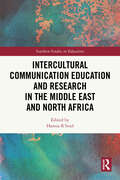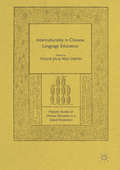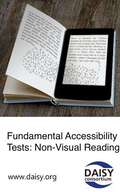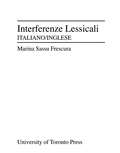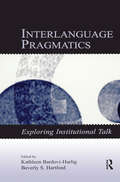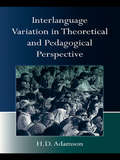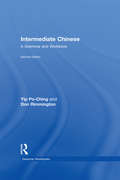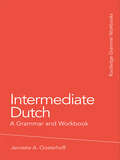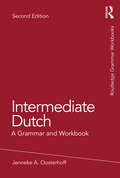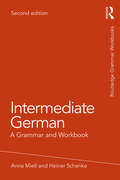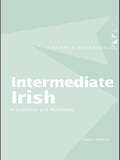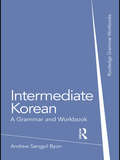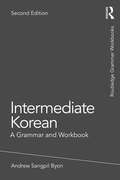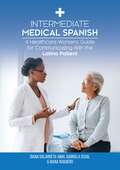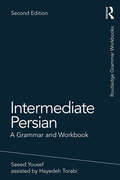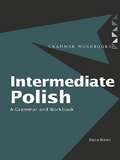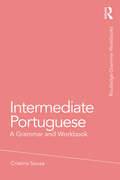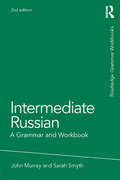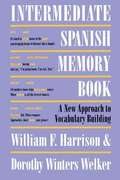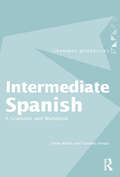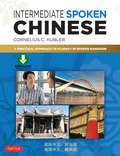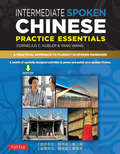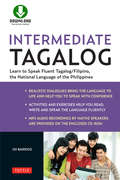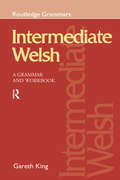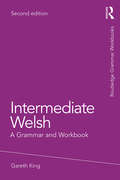- Table View
- List View
Intercultural Communication Education and Research in the Middle East and North Africa (Southern Studies in Education)
by Hamza R’boulThis edited volume gathers insights into the production of knowledge about interculturality in education and research in the Middle East and North Africa (MENA).The MENA region is seen in this book as a space with unique circumstances, conditions and complexities that need to be thoroughly explored and further unpacked. The book defines intercultural communication education and research broadly, but focuses on how teaching and researching interculturality is understood and practiced in MENA formal education classrooms and in various training situations such as business, politics, media and communication. This edited volume aims to (a) navigate representations of intercultural communication in education and research, starting from the premise that interculturality is not only a theory of analysis but also an activism for social and epistemic justice, (b) investigate specific phenomena, challenges and issues in education and research, including concepts/notions such as acculturation and intercultural understanding/empathy, and (c) explore subfields of knowledge such as sense-making and intercultural pragmatics, and specific contexts of interculturality such as immigrants, exchange programs and student mobilities.This book will be valuable read for students, educators, scholars and policymakers interested in intercultural communication and education in the region, as well as language and sociology more broadly.
Interculturality in Chinese Language Education
by Fred Dervin Tinghe JinThis book calls for a change in the way interculturality is introduced in Chinese language education, while the demand for Chinese language teaching increases around the world. The concept of culture - as in the phrase 'Chinese culture' - has often been one of the main emphases of Chinese language education, providing students with facts about China and 'recipes' on how to meet Chinese people and how to behave like them. However, Chinese culture, like all cultures, does not constitute a closed system, but is constantly evolving and exchanging with other cultures. This unique volume comprises studies from around the world that promote intercultural awareness, dialogue, and encounters in Chinese language education. Written in a clear and readable style, this book will appeal to a diverse readership, from practising and training teachers of Chinese, to researchers interested in language and intercultural education.
Interdisciplinary Practices in Academia: Writing, Teaching and Assessment (Routledge Studies in Applied Linguistics)
by Louisa Buckingham Jihua Dong Feng Kevin JiangThis volume addresses the implications that academic interdisciplinarity in the field of English for Academic Purposes (EAP) and English for Specific Purposes (ESP) has for research and pedagogy with a global reach. The Editors present a coherent, research-supported analysis of the influence of interdisciplinary research and methods on the way academics collaborate on courses, develop their careers, and teach students. The hitherto prevalence of disciplinary silo-like approaches to academic and scientific issues is increasingly ceding ground to an interdisciplinary synergy of different methodological and epistemological traditions. In the context of ongoing trends towards interdisciplinarity in degree programmes and the increasing popularity of such degree programmes with students (e.g., bioinformatics, computational linguistics, psycholinguistics, neuropolitics, evolutionary finance, global studies, and security studies), academics and programme administrators need awareness of the skills needed to operate in interdisciplinary contexts. Studies in this edited volume examine interdisciplinary communication practices, and identify how academic writing, teaching, language proficiency assessment and degree programmes are responding to changes in the broader social, institutional and political contexts of academia. As authors in the volume demonstrate, the discursive features, literacy practices and instructional modes, and the student experience of these emerging interdisciplines deserve systematic exploration. This insightful volume sheds light on contexts across the globe and will be used by students studying EAP and ESP pedagogy or practice; academics in the fields of applied linguistics and higher education, as well as higher education faculty and administrators interested in interdisciplinarity in degree programmes.
Interferenze lessicali
by Marina Sassu FrescuraThis workbook deal with lexical interference in Italian and English ? the problem of 'false cognates,' words in one language that resemble words in another language but have different meanings. Aimed at correcting and preventing the most common errors caused by lexical interference and at expanding the student's vocabulary, it is intended for use by students with on or two years' training in Italian in high schools, universities, and community colleges. The workbook contains exercises on specific interferences, twelve recapitulation exercises, a section on interferences of lower frequency, and a set of exercises on which the student can work independently.
Interlanguage Pragmatics: Exploring Institutional Talk (Second Language Acquisition Research Series)
by Kathleen Bardovi-Harlig Beverly S. HartfordThis volume brings conversational analysis into the study of second language pragmatics as an analytic paradigm. A well-regarded team of researchers addresses a difficult area for the interlanguage pragmatics research community--the balance between experimental method and the use of conversational data. Institutional talk provides authentic and consequential talk. The goal of the book is to demonstrate how the investigation of institutional talk balances the researcher's need for comparable and replicable interactions with the need to observe authentic outcomes. The chapters present empirical studies based on quantitative and qualitative analyses, which are carefully illustrated by the real-world variables that each institution controls. The chapters span a range of institutions, including the university writing center, hotels, secondary schools, and employment offices. The variables examined include the traditional ILP variables, such as status, directness, and social distance, as well as new concepts like trust, authority, equality and discourse style.
Interlanguage Variation in Theoretical and Pedagogical Perspective
by H.D. AdamsonIn this book H.D. Adamson reviews scholarship in sociolinguistics and second language acquisition, comparing theories of variation in first and second-language speech, with special attention to the psychological underpinnings of variation theory. Interlanguage is what second language learners speak. It contains syntactic, morphological and phonological patterns that are not those of either the first or the second language, and which can be analyzed using the principles and techniques of variation theory. Interlanguage Variation in Theoretical and Pedagogical Perspective: relates the emerging field of variation in second language learners’ speech (interlanguage) to the established field of variation in native speakers’ speech relates the theory of linguistic variation with psycholinguistic models of language processing relates sociolinguistic variation theory to the theory of Cognitive Grammar suggests teaching applications that follow from the theoretical discussion At the forefront of scholarship in the fields of interlanguage and variation theory scholarship, this book is directed to graduate students and researchers in applied English linguistics and second language acquisition, especially those with a background in sociolinguistics.
Intermediate Chinese: A Grammar and Workbook (Routledge Grammar Workbooks)
by Don Rimmington Po-Ching YipIntermediate Chinese is the ideal reference and practice book for students with some knowledge of the language. Each of the 25 units deals with a particular grammatical point and provides associated exercises. Features include: clear, accessible format many useful language examples jargon-free grammar explanations sample drills and exercises with full answer key All Chinese entries are presented in both pinyin romanisation and Chinese characters, and are accompanied, in most cases, by English translations to facilitate self-tuition in both the spoken and the written language. This new edition also includes a glossary of vocabulary and aglossary of grammatical terms.Intermediate Chinese reviews the principal elements presented in its sister volume, Basic Chinese, and introduces more complicated structures. The two books form a compendium of the essentials of Chinese grammar.
Intermediate Dutch: A Grammar and Workbook (Grammar Workbooks)
by Jenneke A. OosterhoffIntermediate Dutch is designed for learners who have achieved a basic proficiency and wish to refine their knowledge of grammatical structures. This Workbook, along with its companion volume Basic Dutch, provides clear and concise summaries of the essential points of Dutch grammar as well as opportunities to practice using the structures of the language. Building on the lessons of Basic Dutch, each of the twenty-four units presents a grammatical topic with an introduction and overview, followed by contextualized exercises to reinforce learning. Features include: a clear accessible format many useful language examples abundant exercises with a full answer key frequent references to English grammar an appendix on irregular verbs an index of grammatical keywords. Suitable for independent learners and students on taught courses, Intermediate Dutch, together with its sister volume Basic Dutch, forms a structured course in the essentials of Dutch grammar.
Intermediate Dutch: A Grammar and Workbook (Routledge Grammar Workbooks)
by Jenneke A. OosterhoffIntermediate Dutch is designed for learners who have achieved a basic proficiency and wish to refine their knowledge of grammatical structures. This second edition offers new and revised exercises, sections on spelling and punctuation, and useful insight into differences in Flemish varieties of Dutch which may confuse learners.This Grammar, along with its companion volume Basic Dutch, provides clear and concise summaries of the essential points of Dutch grammar as well as opportunities to practice using the structures of the language. Building on the lessons of Basic Dutch, each of the 24 units presents a grammatical topic with an introduction and overview, followed by contextualized exercises to reinforce learning.Features include:· clear accessible format· many useful language examples· abundant exercises with full answer key· frequent references to English grammar· appendices on pronunciation, spelling, and strong verbs· index of grammatical keywords· glossary of words used in the exercisesSuitable for independent learners and students on taught courses, Intermediate Dutch, together with its sister volume Basic Dutch, forms a structured course in the essentials of Dutch grammar.
Intermediate German: A Grammar and Workbook (Grammar Workbooks)
by Heiner Schenke Anna MiellIntermediate German: A Grammar and Workbook is designed for learners who have achieved basic proficiency and now wish to progress to more complex language. Each of the units combines concise grammar explanations with examples and exercises to help build confidence and fluency. The new edition includes: up-to-date cultural aspects of German-speaking countries extended entries on adverbs and the imperative Did you know? sections with tips on learning strategies, and on contemporary usage more exercises to refine retention Suitable for students learning with or without a teacher, Intermediate German forms a structured course of the essentials of German grammar and is suitable for students at intermediate level, corresponding to levels A2–B1+ on the CEFR or Intermediate High/Advanced Low with the ACTFL.
Intermediate Irish: A Grammar and Workbook
by Nancy StensonIntermediate Irish is a jargon-free workbook examining the most commonly used grammatical structures within the Irish language. Focusing on the repeated use of grammatical patterns, the Grammar develops an understanding of the structures presented, making the forms familiar and automatic for learners. This user-friendly workbook includes: terminology introduced and explained with multiple examples exercises in the grammatical forms introduced in the text translation exercises an exercise key.
Intermediate Korean: A Grammar and Workbook (Grammar Workbooks)
by Andrew Sangpil ByonIntermediate Korean: A Grammar and Workbook comprises an accessible reference grammar and related exercises in a single volume. This workbook presents twenty-four individual grammar points, covering the core material which students would expect to encounter in their second year of learning Korean. Grammar points are followed by examples and exercises which allow students to reinforce and consolidate their learning. Intermediate Korean is suitable for both class use as well as independent study. Key features include: clear, accessible format many useful language examples all Korean entries presented in Hangul with English translations jargon-free explanations of grammar abundant exercises with full answer key subject index. Clearly presented and user-friendly, Intermediate Korean provides readers with the essential tools to express themselves in a wide variety of situations, making it an ideal grammar reference and practice resource for students with some knowledge of the language.
Intermediate Korean: A Grammar and Workbook (Routledge Grammar Workbooks)
by Andrew Sangpil ByonThis revised second edition of Intermediate Korean: A Grammar and Workbook is an accessible reference grammar and related exercises in a single volume. The text can be used in conjunction with any primary textbook, both as a reference guide to the intermediate Korean grammar and a practice book to reinforce learning. This book presents 24 individual grammar points, covering the core material that students would expect to encounter in their second year of learning Korean. Grammar points are followed by examples and exercises which allow students to reinforce and consolidate their learning. Key features include: Clear, accessible format Many useful language examples All Korean entries presented in Hangul with English translations Abundant exercises with full answer key Subject index. Clearly presented and user-friendly, Intermediate Korean provides readers with the essential tools to express themselves in a wide variety of situations, making it an ideal grammar reference and practice resource for students with some knowledge of the language. Intermediate Korean is suitable for both class use as well as independent study.
Intermediate Medical Spanish: A Healthcare Workers’ Guide for Communicating With the Latino Patient
by Segal Diana Ruggiero (Galarreta-Aima)This is an intermediate/advanced level textbook directed toward students who are interested in learning the necessary medical terminology and cultural sensitivity to successfully care for the U.S. Spanish-speaking community in medical contexts. This textb
Intermediate Persian: A Grammar and Workbook (Routledge Grammar Workbooks)
by Saeed Yousef Hayedeh TorabiIntermediate Persian: A Grammar and Workbook comprises accessible grammar exercises in a single volume. Each of the 14 units deals with a particular grammatical point and provides associated exercises to help learners reinforce and consolidate their knowledge. In addition, it features four appendices, covering colloquial, polite, literary and journalistic styles. Intermediate Persian reviews the principles presented in Basic Persian and introduces more-advanced features and structures of the language. User-friendly and engaging, Intermediate Persian is suitable for both class use and independent study. This edition is completely revised with additional features, such as a review chapter and translations of all the examples.
Intermediate Polish: A Grammar and Workbook (Routledge Grammar Workbooks)
by Dana BielecIntermediate Polish is designed for learners who have achieved basic proficiency and wish to progress to more complex language. Each unit combines clear, concise grammar explanations with examples and exercises to help build confidence and fluency. Features include:* focus on areas of particular confusion such as verbs that are difficult to translate and nouns made from numbers * comprehensive glossary of grammatical terms* reference list of over 250 Polish verbs* full key to all exercises.Suitable for independent learners and students on taught courses, Intermediate Polish, together with its sister volume, Basic Polish, forms a structured course in the essentials of Polish. Dana Bielec is the author of the popular Polish: An Essential Grammar, as well as Basic Polish: A Grammar and Workbook, both published by Routledge.
Intermediate Portuguese: A Grammar and Workbook (Routledge Grammar Workbooks)
by Cristina SousaIntermediate Portuguese: A Grammar and Workbook is an accessible reference grammar presenting twenty-two individual grammar points in realistic contexts with practise exercises in each unit designed to reinforce and consolidate learning.This comprehensive volume takes a grammatical approach which encourages students to familiarise themselves with the grammar points in each unit, using a wide variety of contemporary vocabulary that can be applied to different settings such as work, shopping, tourism, business, education and socialising. Key features include: grammar exercises and a full answer key frequent comparative references to English grammar a list of key vocabulary at the end of each unit a glossary of grammatical terms Providing readers with the essential tools to express themselves in a wide variety of situations, Intermediate Portuguese is an essential resource for students with beginner to intermediate knowledge of the language and is suitable for both class-based learning and independent study.
Intermediate Russian: A Grammar and Workbook (Routledge Grammar Workbooks Ser.)
by John Murray Sarah SmythIntermediate Russian provides a reference grammar and related exercises in one volume. Varied texts from Russian sources give an insight into contemporary Russian society and culture. Features include: * texts and exercises reflecting contemporary Russian* concise grammar explanations* full exercise key * detailed index.Intermediate Russian, and its sister volume, Basic Russian, are ideal both for independent study and use in class. Together the books provide a compendium of the essentials of Russian grammar.
Intermediate Spanish Memory Book: A New Approach to Vocabulary Building
by William F. Harrison Dorothy Winters WelkerMnemonics is an age-old device for remembering names, numbers, and many other things. As in the authors' previous Memory Books, the Intermediate Spanish Memory Book makes use of this reliable memory help in a series of mnemonic jingles that are by turns playful, sardonic, touching, and heroic to help both students and independent learners acquire and remember Spanish vocabulary. The 500-plus words in this book represent a more advanced vocabulary than those in the Spanish Memory Book (1990) and the Spanish Memory Book, Junior Edition (1993).
Intermediate Spanish: A Grammar and Workbook (Grammar Workbooks)
by Irene Wilkie Carmen ArnaizThis text is designed for learners who have achieved basic proficiency and wish to progress to more complex language. Each of the units combines concise grammar explanations with examples and exercises to help build confidence and fluency. Features include: clear explanations of the similarities and differences in English and Spanish grammar authentic language examples from a range of contemporary media reading comprehensions at the end of each unit full cross-referencing throughout extra tips on language learning and learning specific grammar points. Suitable for students learning with or without a teacher, Intermediate Spanish, together with Basic Spanish form a structured course in the essentials of Spanish grammar.
Intermediate Spoken Chinese
by Cornelius C. KublerWelcome to the world's most effective method of learning Mandarin! This widely-acclaimed series continues to impress and inspire learners whether they're studying Chinese on their own, or in a classroom setting. Intermediate Spoken Chinese and the corresponding Practice Essentials allow you to experience real-life situations in different Mandarin-speaking locales. Each of the common situations explored here—from shopping at a market to playing unexpected phone tag—is one you're most likely to encounter as you interact with Mandarin Chinese speakers. An accompanying MP3 audio–CD and software DVD reinforce listening comprehension and correct pronunciation. The breakthrough foundation of these books is that you don't need to know the characters in order to speak and understand Chinese. This series provides separate "tracks" to help you master the skills of speaking and writing Chinese at your own pace. Some learners wish to learn reading and writing as well as speaking, while others focus on developing their knowledge of spoken Chinese first, and then learn the characters. Both approaches are perfectly valid ways to learn Chinese, and the one you adopt will depend on your personal goals and the amount of time you have for weekly study. This series allows you total flexibility in this regard. Additional key features of Intermediate Spoken Chinese: Clear and detailed explanations of natural, colloquial Chinese pronunciation, grammar and usage. Recommended strategies to help you learn to speak Chinese more efficiently. Notes on Chinese culture and society allow you to understand situational etiquette. Discussions of challenges faced by English speakers who are learning Chinese and how to overcome them. A digital Instructors Guide is available gratis from the publisher. A digital Chinese Character Transcription (simplified and traditional characters) The MP3 audio CD and software DVD feature: 56 videos with dozens of native speakers filmed on location in mainland China, Hong Kong, Macao, Taiwan, Singapore, and Malaysia. 6 hours of native–speaker audio, including all of the book's conversations. Build up sections, new words, and pronunciation exercises. Available separately, Intermediate Spoken Chinese Practice Essentials is the companion workbook for Intermediate Spoken Chinese. This practical guide includes a broad range of drills and exercises designed to dramatically enhance your proficiency in speaking and comprehending. While designed for use with the companion textbook, it can be used together with any Chinese textbook or teaching program to hone your Chinese language skills.
Intermediate Spoken Chinese Practice Essentials: A Wealth of Activities to Enhance Your Spoken Mandarin (DVD Included)
by Cornelius C. Kubler Yang Wang"Meticulously planned, carefully prepared and patiently tested for over a decade, the Basic Chinese series represents the most comprehensive introductory materials available now. The eclectic approach, the flexibility in use, the attention to authenticity of language in its sociolinguistic context, the myriad of audio and visual aids, and the array of rigorously designed exercises makes the Basic Chinese the ideal material for any committed learner embarking on the journey of learning the Chinese language." --Dr. Jun Yang, Senior Lecturer in Chinese, University of Chicago
Intermediate Tagalog
by Joi BarriosAt last, a way to improve your Tagalog! Written by Joi Barrios as the continuation of her best-sellingTagalog for Beginners book,Intermediate Tagalog is the first intermediate-level book designed specifically for people who already speak or understand some basic Tagalog and now wish to achieve greater fluency in speaking, reading and writing standard Filipino—the national language of the Philippines. The carefully-constructed lessons in this book point out common grammatical errors that English speakers make when speaking Tagalog, and present "real-life" conversations demonstrating how the language is spoken in Manila today. Extensive cultural notes are provided, along with exercises and activities that introduce the use of the Tagalog language in a wide range of everyday situations. The 20 lessons give you all the basic skills needed to speak Tagalog fluently:paglalarawan (the ability to describe people, places and feelings);pagsasalaysay (the ability to tell a story—whether a news story, a folktale, or an anecdote);paglalahad (how to explain something—for example, a custom or tradition, or how to cook a dish); andpangangatuwiran (reasoning and abstract thinking). Each lesson is carefully structured in six key parts: A "real-life" dialogue providing valuable conversational skills. Avocabulary list to expand your familiarity with common, everyday Tagalog words and expressions. A grammar review section (for example, on the correct uses of affixes in various sentence constructions). Insightful cultural notes presenting aspects of the Philippines that may seem "odd" to outsiders, to explain how Filipino culture shapes the way people speak. A reading passage from a story or newspaper article, with comprehension questions. A writing exercise designed to teach a specific writing skill. UsingIntermediate Tagalog, you'll be able to talk about yourself, your family and your daily experiences using grammatically correct sentences and a native-speaker level vocabulary.
Intermediate Welsh: A Grammar and Workbook
by Gareth KingIntermediate Welsh is designed for learners who have achieved basic proficiency, and wish to proceed to more complex language. It presents a broad range of grammatical topics, illustrated by examples which serve as models for the varied exercises which follow. The emphasis throughout is on colloquial, spoken Welsh used by modern day native speakers.
Intermediate Welsh: A Grammar and Workbook (Grammar Workbooks)
by Gareth KingIntermediate Welsh: A Grammar and Workbook is designed for learners who have achieved basic proficiency and wish to proceed to more complex language. It presents a broad range of grammatical topics, illustrated by examples, which serve as models for the varied exercises that follow. The emphasis throughout is on colloquial spoken Welsh used by modern-day native speakers. Features include: a clear, accessible format; many useful language examples; jargon-free grammar explanations; sample drills and exercises; a full key to the exercises. This new edition has been redesigned for greater clarity and further examples have been updated.
